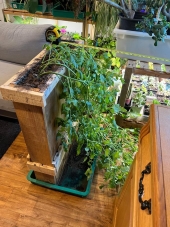









Order copies of my book, Dairy Farming: The Beautiful Way at
www.createspace.com
Help spread the word! Thanks!
struggle - hustle - soul - desire
 1
1




 1
1




He who sweats most in times of peace,
bleeds least in times of war.








Subtropical desert (Köppen: BWh)
Elevation: 1090 ft Annual rainfall: 7"




"Turn your face to the sun and the shadows fall behind you." ~Maori Proverb
www.permi-eden.com




Dustin Powers wrote:I didnt love my soil cube until I used them on a wicking watering mat. Cubes stopped falling apart, root growth in its hunt for water was stronger therefore holding the cubes together better, and I just used a mix of my garden soil and some light potting soil.
It was always the watering that broke the top corners off my cubes.





I like to use the most natural materials I can. So if anyone has other suggestions (other than newspaper, haha) I'd appreciate it.




 1
1
















 1
1








Standing on the shoulders of giants. Giants with dirt under their nails




Medicinal herbs, kitchen herbs, perennial edibles and berries: https://mountainherbs.net/ grown in the Blue Mountains, Australia




Living a life that requires no vacation.




 1
1




 Also, I'm a newbie, with no complete education, I'm just experimenting with whatever seemed reasonable and cool at the same time
Also, I'm a newbie, with no complete education, I'm just experimenting with whatever seemed reasonable and cool at the same time 




Gardening in Montreal (indoors, urban, 6b) and the Laurentians (sandy to sandy loam, boreal forest, 4a)




Peter Smith wrote: So, I am making plans for my first semi-commercial farm garden. I hate those silly plastic pots that end up all over, and I am interested in trying soil blocks.
Pros
Hopefully cheaper
Healthier plant roots
No plastic pots
Cons
Finicky soil mix
Fall apart ?
This is what I am finding, and Elliott Coleman makes it look very easy. I have no personal experience, so I'm wondering if anybody has tricks, tips, warnings, endorsements, soil mixes. Or is nobody using these.
Coleman's mix is
3 parts peat
3 parts compost
1 part pearlite
Plus minerals and fertilizer








Gardening in Montreal (indoors, urban, 6b) and the Laurentians (sandy to sandy loam, boreal forest, 4a)





|
There's a hole in the bucket, dear Liza, dear Liza, a hole in the bucket, dear liza, a tiny ad:
The new kickstarter is now live!
https://www.kickstarter.com/projects/paulwheaton/garden-cards
|




